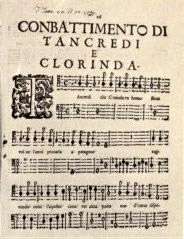Il combattimento di Tancredi e Clorinda
Il combattimento di Tancredi e Clorinda (The Combat of Tancredi and Clorinda), SV 153, is an operatic scena for three voices by Claudio Monteverdi, although many dispute how the piece should be classified. The piece has a libretto drawn from Torquato Tasso's La Gerusalemme Liberata ("Jerusalem Delivered", Canto XII, 52–62, 64–68), a Romance set against the backdrop of the First Crusade, when Godfrey of Bouillon conquered Jerusalem.[1] Il Combattimento was first produced in 1624[2] but not printed until 1638, when it appeared with several other pieces in Monteverdi's eighth book of madrigals which were written over a period of many years.
| Il combattimento di Tancredi e Clorinda | |
|---|---|
| Operatic scena by Claudio Monteverdi | |
 Printed part | |
| Catalogue | SV 153 |
| Language | Italian |
| Based on | La Gerusalemme Liberata by Torquato Tasso |
| Performed | 1624 |
| Published | 1638 |
| Scoring |
|
In Il Combattimento, the orchestra and voices form two separate entities. The strings are divided into four independent parts instead of the usual five – an innovation that was not generally adopted by European composers until the 18th century.
Il combattimento contains one of the earliest known uses of pizzicato in Baroque music, in which the players are instructed to set down their bows and use two fingers of their right hand to pluck the strings. It also contains one of the earliest uses of the string tremolo, in which a particular note is reiterated as a means of generating excitement. This latter device was so revolutionary that Monteverdi had considerable difficulty getting the players of his day to perform it correctly. These innovations, like the fourfold division of the strings, were not taken up by Monteverdi's contemporaries or immediate successors.
References
- Whenham, John (2014). "Combattimento di Tancredi e Clorinda, SV153". Hyperion Records. Retrieved 13 May 2020.
- "The History of Orchestration". Opera Scotland. 2017. Retrieved 13 May 2020.
Sources
- Combattimento di Tancredi e Clorinda, SV 153: Scores at the International Music Score Library Project (IMSLP)
- Libretto of Il Combattimento di Tancredi e Clorinda, opera.stanford.edu
- Carse, Adam (1964) [1925]. The History of Orchestration. Dover Publications, New York. ISBN 0-486-21258-0.
- Gerald Drebes (1991). "Monteverdis Kontrastprinzip, die Vorrede zu seinem 8. Madrigalbuch und das Genere concitato". Musiktheorie (in German). 6 (1): 29–42. Archived from the original on 2016-03-03.
- Monteverdi's Il combattimento di Tancredi e Clorinda, operakey.com 2019